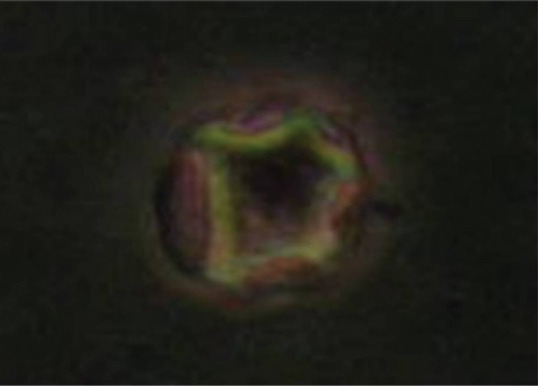Sir,
Free-living amoeba namely, Acanthamoeba, Naegleria, Balamuthia, and Sappinia, are known to cause central nervous system infections in human. Keratitis due to Acanthamoeba is well reported, and few reports from the Northeast region of India also exist.[1,2] Apart from infections, they are also known to harbor pathogenic bacteria and may also be the agent for survival of Vibrio during the interepidemic period.[3] Even though so far no evidence exists, these parasites could be the eitologies for few of the undiagnosed cases of fatal meningoencephalitis in this region since they are found spread in the environment including pond water with which rural population are in constant contact. The cysts of these free-living amoeba are known to survive under harsh conditions in these environments, hence can prove dangerous for human population.[4,5] The present study aimed at looking at the prevalence of Acanthamoeba in the pond water of this region since eye infection due to this parasite is well known in this region.
We collected 18 samples from different ponds of Dibrugarh district of Assam during the month of March–April 2012. About 500 ml of water was collected from each pond using autoclaved bottles. The whole amount was then filtered through 0.58 μm pore size nitrocellulose membrane using vacuum. The membrane was then placed onto a nonnutrient agar medium which was prepared using Page's amoeba Saline prepared as reported by others.[6] Page's amoeba Saline is composed of 2.5 mM NaCl, 1 mM KH2PO4, 0.5 mM Na2HPO4, 40 μm CaCl26H2O, and 20 μm MgSO2.7H2O. The plates were then incubated at room temperature and inspected daily for 2 weeks followed by weekly intervals for 2 months for the presence of trophozoites or cysts.
Both cystic and trophozoite forms of the amoeba were detected in the water samples. Identification was based on morphology. The cysts were identified by their two-layered cell wall appearance, the outer being wrinkled, whereas the inner being hexagonal, star, or spherical shaped [Figure 1]. Trophozoite form with spine-like projection was also observed. A total of 6 out of the 18 samples were positive for the ameba. Three of them were positive after 1 week, one at 2nd week, and the rest after 1 month.
Figure 1.

Cyst of Acanthamoeba isolated from pond water in Dibrugarh, India
We could isolate Acanthamoeba from pond water of Dibrugarh district of this region, an evidence supporting the fact that the pond water of this region could serve as a contact area for susceptible human population to acquire these amebic infection. Worldwide, reports of cases of acanthamoeba keratitis as well as meningoencephalitis from rural areas exist. As people belonging to rural areas of this region are in constant exposure to pond water, they are at a risk for acquiring infection with this amoeba and hence of concern.
Financial support and sponsorship
Nil.
Conflicts of interest
There are no conflicts of interest.
Acknowledgment
The authors acknowledge the intramural fund received from RMRC, Dibrugarh, for carrying out field work.
REFERENCES
- 1.Nath R, Baruah S, Saikia L, Devi B, Borthakur AK, Mahanta J, et al. Mycotic corneal ulcers in upper Assam. Indian J Ophthalmol. 2011;59:367–71. doi: 10.4103/0301-4738.83613. [DOI] [PMC free article] [PubMed] [Google Scholar]
- 2.Nath R, Boruah S, Gogoi T, Mahanta J, Saikia L. Keratitis due to Staphylococcus aureus and Acanthamoeba species following injury. Trop Parasitol. 2013;3:86–8. doi: 10.4103/2229-5070.113925. [DOI] [PMC free article] [PubMed] [Google Scholar]
- 3.Abd H, Shanan S, Saeed A, Sandström G. Survival of Vibrio cholerae inside Acanthamoeba and detection of both microorganisms from natural water samples may point out the amoeba as a protozoal host for V. cholerae. J Bacteriol Parasitol. 2011:S1–003. [Google Scholar]
- 4.Marciano-Cabral F, Cabral G. Acanthamoeba spp. as agents of disease in humans. Clin Microbiol Rev. 2003;16:273–307. doi: 10.1128/CMR.16.2.273-307.2003. [DOI] [PMC free article] [PubMed] [Google Scholar]
- 5.Schuster FL, Visvesvara GS. Free-living amoebae as opportunistic and non-opportunistic pathogens of humans and animals. Int J Parasitol. 2004;34:1001–27. doi: 10.1016/j.ijpara.2004.06.004. [DOI] [PubMed] [Google Scholar]
- 6.Rezaeian M, Niyyati M, Farnia Sh, Haghi AM. Isolation of Acanthamoeba spp. from different environmental sources Iranian. J Parasitol. 2008;3:44–7. [Google Scholar]


